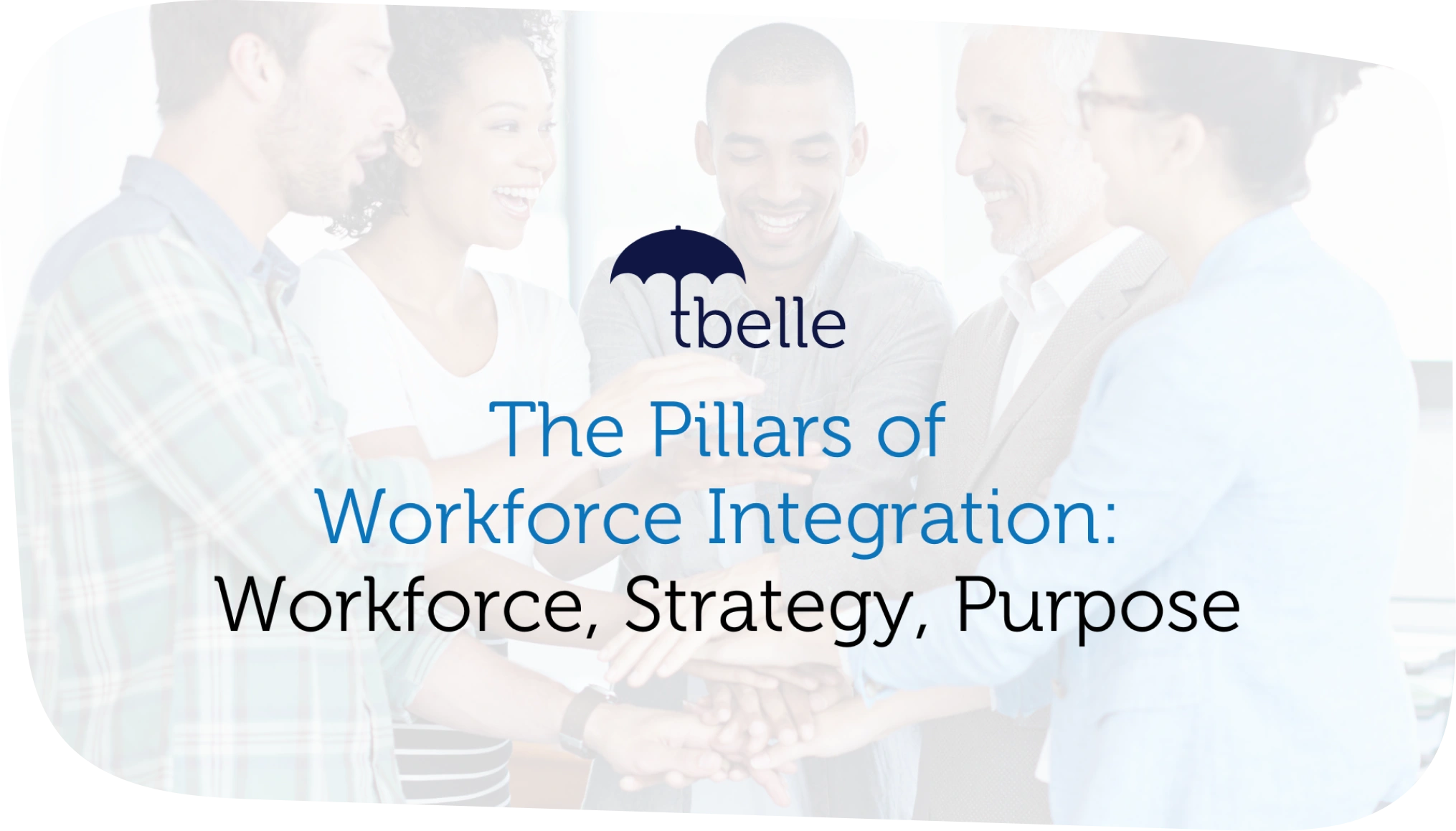
A Gallup 2024 report reveals that only 23% of the global workforce are engaged, as of 2023.
Table of Contents
According to Gallup’s State of the Global Workplace 2024 Report, the percentage of engaged employees globally who feel involved in and enthusiastic about their work remains at 23%. This finding emphasizes the need for companies to rethink how they align their employees with their overall goals and purpose.
One powerful solution lies in workforce integration, where the alignment of workforce, strategy, and purpose creates a cohesive, engaged, and motivated team. These three pillars—are interdependent and, when integrated effectively, lead to higher employee engagement, improved performance, and long-term profitability. This article will explore the role of each pillar, supported by positive statistics, and illustrate the immense value of workforce integration.
The Pillars of Workforce Integration
Workforce integration refers to the seamless alignment of an organization’s employees with its strategy and overarching purpose. Especially in this era where remote work is a hype, building a team that operates from different locations but still feels connected to their colleagues and aligned with the company’s purpose is essential. To achieve this, organizations must be deliberate in creating an environment where remote employees feel engaged and connected, ensuring that the company’s mission and strategy are effectively communicated and embraced across all teams.
Workforce integration is not yet widely adopted across organizations, with many businesses still operating in silos where strategy, purpose, and workforce engagement remain disconnected. However, Tbelle aims to take the lead in this emerging field by equipping organizations with the tools and strategies needed to effectively implement workforce integration. Through targeted initiatives and expert guidance, Tbelle seeks to help companies align their workforce, strategy, and purpose to drive long-term success and innovation.

In traditional terms, workforce is defined as simply the collective group of employees, teams, and departments within an organization. Their focus tends to be on managing this group to ensure productivity, efficiency, and the fulfilment of daily tasks.
In the concept of Workforce Integration, the definition of the workforce goes beyond managing tasks and operations. It involves creating a deeper alignment between employees and the organization’s strategy and purpose. When employees feel connected to the company’s mission and understand how their roles contribute to broader goals, they are more likely to be engaged. Employee engagement—the level of involvement, enthusiasm, and commitment employees have towards their work—directly influences productivity and organizational success.
A Gallup survey reveals that companies with highly engaged employees experience 21% greater profitability and 17% higher productivity than those with disengaged workers. An integrated workforce is one that understands its role within the larger organizational framework, actively contributing to the company’s goals. Workforce integration promotes better communication, collaboration, and innovation.

Most leaders define strategy as the overarching plan or roadmap that guides an organization toward achieving its business goals. This typically involves setting financial targets, identifying competitive advantages, and making decisions about resource allocation.
Within the concept of Workforce Integration, however, strategy is defined not just as a high-level plan but as a shared vision that must be deeply understood and embraced by the entire workforce. Instead of being confined to the executive level, strategy in workforce integration is cascaded throughout the organization, ensuring that every employee knows how their work contributes to larger objectives.
This approach transforms strategy from a top-down directive into a dynamic, company-wide effort where employees are empowered to align their daily tasks with the organization’s mission and long-term goals. It fosters accountability, engagement, and a sense of purpose among all team members.

Purpose is the fundamental reason for an organization’s existence, beyond making a profit. Generally, purpose in organizations is defined as the mission or reason for a company’s existence, that serves as a high-level message intended to inspire employees and signal corporate values.
In the concept of Workforce Integration, purpose becomes a core element that provides the motivational aspect driving the workforce. It ensures that every member of the organization is united in working toward a shared goal, cultivating a sense of meaning and dedication, encouraging commitment across the team. Purpose in this context is continuously woven into daily tasks, team discussions, and decision-making processes, making it a living, breathing part of the organizational culture.
It’s about ensuring that every team member feels connected to the company’s larger mission and understands how their individual contributions align with that purpose. This consistent engagement with purpose helps employees find deeper meaning in their work, driving commitment, motivation, and a shared sense of importance within the organization.
Tbelle Insight:
Purpose-driven companies witness higher market share gains and grow three times faster on average than their competitors – Deloitte
Purpose-driven companies are those that prioritize not only financial success but also societal and environmental impact. These companies are outperforming their competitors. According to a Deloitte Insights report, purpose-driven organizations report 40% higher levels of employee retention, as employees are more likely to remain loyal to companies whose missions align with their personal values.
Synergy Between Workforce, Strategy, and Purpose
When the workforce, strategy, and purpose are effectively integrated, organizations experience significant gains in performance and employee satisfaction. Research shows that purpose-driven companies have 30% higher levels of innovation. Teams that understand how their roles align with both the strategy and purpose of the organization are more likely to stay with the company long-term.
In workforce integration, achieving synergy between workforce, strategy, and purpose, is essential, as it ensures that employees are aligned with the organization’s goals and mission. When these three elements are effectively integrated, organizations experience significant gains in performance and employee satisfaction.
Research shows that purpose-driven companies witness higher market share gains all while achieving higher workforce and customer satisfaction. Teams that understand how their roles align with both the strategy and purpose of the organization are more likely to stay with the company long-term, reducing turnover and fostering loyalty. Workforce integration creates a cohesive environment where employees are motivated and engaged, driving the organization’s success.
Impact on Organizational Culture

The integration of these pillars fosters a culture of engagement, innovation, and adaptability. Over 80% of executives agree that a strong connection to company purpose drives employee satisfaction. When employees understand and embrace the company’s mission, they become more engaged and motivated to contribute to its success.
These three important pillars can build a culture where transparency and trust thrive. Employees who feel consistently aligned with the company’s goals and values are not only more engaged but also more likely to collaborate and take initiative. As a result, the organization becomes more adaptable, able to swiftly respond to market changes and challenges with a unified, purpose-driven approach.
Recommendations
The integration of workforce, strategy, and purpose is critical to the long-term success of any organization. By aligning these pillars, companies can create a culture of engagement, innovation, and resilience, driving sustained growth and profitability.
Backed up by studies, it clearly shows that organizations that invest in workforce development, define a clear strategy, and cascade their purpose to the team outperform their peers in every area of business.
For companies looking to integrate their workforce, strategy, and purpose, the following steps are recommended:
Prioritize employee engagement, training, and diversity initiatives.
Ensure that strategic initiatives are aligned with the company’s mission and long-term goals.
Cascade the company’s purpose to every level of the organization to ensure that employees understand how their work contributes to the larger mission.
Encourage leaders to model the values of purpose and strategy integration, promoting transparency and collaboration across teams.










